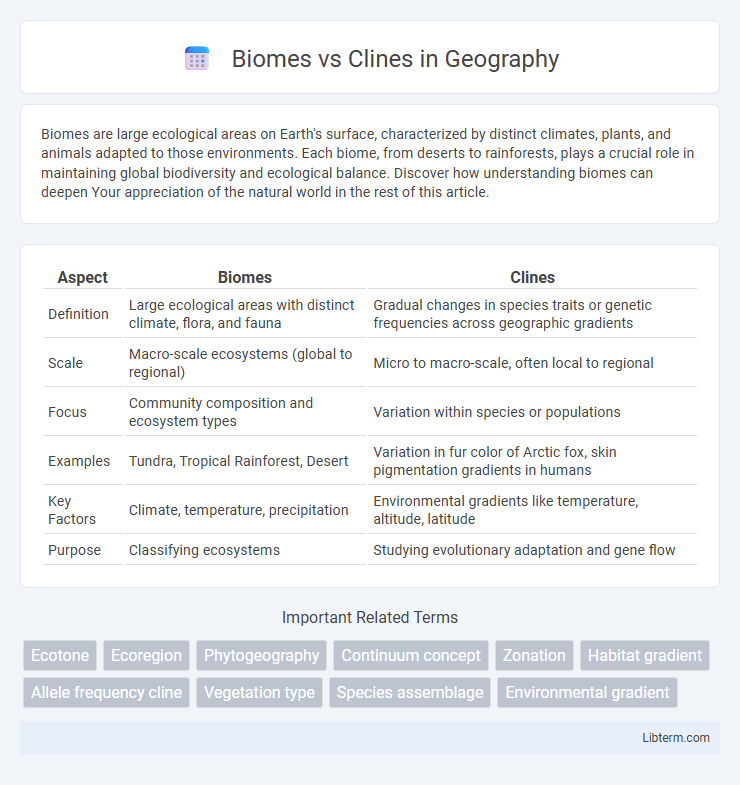Biomes are large ecological areas on Earth's surface, characterized by distinct climates, plants, and animals adapted to those environments. Each biome, from deserts to rainforests, plays a crucial role in maintaining global biodiversity and ecological balance. Discover how understanding biomes can deepen Your appreciation of the natural world in the rest of this article.
Table of Comparison
| Aspect | Biomes | Clines |
|---|---|---|
| Definition | Large ecological areas with distinct climate, flora, and fauna | Gradual changes in species traits or genetic frequencies across geographic gradients |
| Scale | Macro-scale ecosystems (global to regional) | Micro to macro-scale, often local to regional |
| Focus | Community composition and ecosystem types | Variation within species or populations |
| Examples | Tundra, Tropical Rainforest, Desert | Variation in fur color of Arctic fox, skin pigmentation gradients in humans |
| Key Factors | Climate, temperature, precipitation | Environmental gradients like temperature, altitude, latitude |
| Purpose | Classifying ecosystems | Studying evolutionary adaptation and gene flow |
Introduction to Biomes and Clines
Biomes are large ecological units characterized by similar climate, vegetation, and animal life, such as tropical rainforests, deserts, and tundras, spanning extensive geographical areas. Clines refer to gradual changes in phenotypic traits or genetic frequencies within a species across a geographical gradient, often influenced by environmental factors like temperature or altitude. Understanding biomes provides insight into broad ecosystem patterns, while clines explain intraspecific variation driven by spatial environmental gradients.
Defining Biomes: Large-scale Ecosystems
Biomes are large-scale ecosystems characterized by distinct climate conditions, vegetation types, and animal communities, such as tropical rainforests, deserts, and tundras. These broad ecological units cover vast geographic areas and are primarily defined by abiotic factors like temperature and precipitation patterns. Biomes serve as foundational frameworks for understanding biodiversity distribution and ecological processes on a global scale.
Clines: Gradual Biological Variation Explained
Clines represent gradual changes in biological traits or allele frequencies across geographical gradients, illustrating how species adapt continuously to varying environmental conditions. Unlike biomes, which categorize large ecological zones based on distinct climate and vegetation types, clines highlight subtle, progressive genetic or phenotypic shifts within populations. This gradual variation plays a crucial role in evolutionary biology by demonstrating how local adaptation and gene flow interact across spatial scales.
Key Differences Between Biomes and Clines
Biomes are large ecological areas characterized by distinct climate, flora, and fauna, such as deserts, forests, and tundras, whereas clines represent gradual changes in species' genetic traits or phenotypes across geographical gradients. Biomes emphasize environmental conditions and ecosystem types, while clines highlight intraspecific variation influenced by factors like temperature, altitude, or latitude. Understanding these differences is crucial for ecological studies, biodiversity conservation, and predicting species' responses to climate change.
How Climate Shapes Biomes
Climate plays a crucial role in shaping biomes by determining temperature ranges, precipitation levels, and seasonal patterns essential for the survival of plant and animal species. Distinct biomes such as tropical rainforests, deserts, and tundras emerge due to variations in climate across regions. These climatic factors influence soil types, vegetation structure, and biodiversity, which collectively define the characteristics of each biome.
Role of Environmental Gradients in Clines
Environmental gradients play a crucial role in the formation of clines by driving gradual changes in species' phenotypic or genetic traits along geographic or climatic gradients. Unlike biomes, which are distinct ecological communities defined by broad environmental conditions, clines reflect continuous variations influenced by factors such as temperature, humidity, altitude, and soil composition. These gradients facilitate adaptive responses and evolutionary processes in populations, resulting in smooth transitions rather than abrupt boundaries seen in biome delineations.
Examples of Major Biomes Worldwide
Tropical rainforests, deserts, tundras, and grasslands represent major biomes characterized by distinct climate conditions, vegetation, and animal life. The Amazon Basin exemplifies tropical rainforest biomes with high biodiversity and dense canopy cover, while the Sahara Desert illustrates arid biomes marked by sparse vegetation and extreme temperature fluctuations. In contrast, clines describe gradual changes in species traits or genetic composition across geographic gradients rather than discrete ecosystem types.
Notable Clines in Nature
Notable clines in nature include the Bergmann's rule cline, where body size increases in colder climates, and the Allen's rule cline, showing shorter limbs in animals living in cold environments. Another important cline is the sickle cell allele frequency gradient in malaria-endemic regions, illustrating genetic adaptation to environmental pressures. These clines demonstrate gradual genetic or phenotypic changes driven by climatic or ecological gradients, distinct from the broad ecological zones defined by biomes.
Importance of Understanding Biomes and Clines
Understanding biomes and clines is crucial for biodiversity conservation and ecological research because biomes represent large-scale ecosystems with distinct climate and vegetation patterns, while clines illustrate gradual genetic or phenotypic changes within species across geographic gradients. This knowledge helps predict species' responses to climate change and guides the management of natural resources and habitat protection. Accurate identification of biomes and clines informs strategies for maintaining ecosystem resilience and preventing biodiversity loss in changing environments.
Biomes vs Clines: Implications for Conservation
Biomes represent broad ecological zones characterized by distinct climate patterns, flora, and fauna, whereas clines describe gradual changes in species traits or genetic variation across geographical gradients. Conservation strategies targeting biomes emphasize protecting extensive habitats and ecosystem processes, while those focused on clines prioritize preserving genetic diversity and adaptive variation within species. Understanding the interplay between biomes and clines is critical for designing effective conservation plans that maintain both ecosystem integrity and evolutionary potential.
Biomes Infographic

 libterm.com
libterm.com